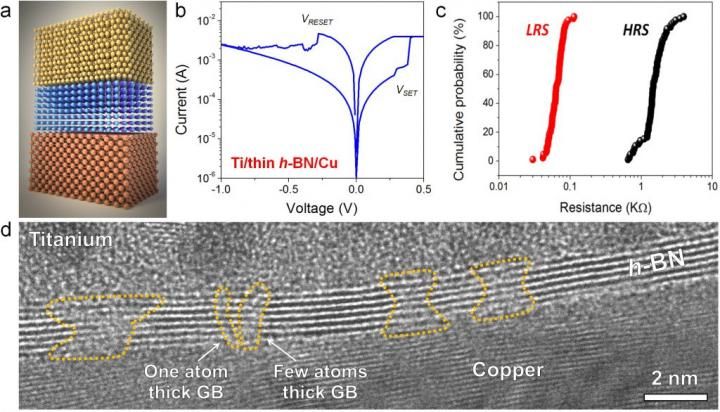Hexagonal boron nitride enables the fabrication of 2-dimensional electronic memories
The use of two dimensional (2D) layered materials to improve the capabilities of electronic devices is a promising strategy that has recently gained much interest in both academia and industry. However, while the research in 2D metallic and semiconducting materials is well established, detailed knowledge and applications of 2D insulators are still scarce.

(a) Schematic of a Ti/thin h-BN/Cu RRAM device. (b) Typical I-V curves in a Ti/thin h-BN/Cu RRAM device showing bipolar RS. (c) Cumulative distribution of the resistance per cycle in HRS and LRS read at 0.1 V. (d) Cross-sectional TEM image showing defective paths (GBs) through the h-BN.
Copyright Wiley-VCH 2017. Reproduced with permission from the authors.
The research group lead by Dr. Mario Lanza, a Young 1000 Talent Professor born in Barcelona (Spain) and based in Soochow University (China), is leading a global effort to investigate the properties of layered dielectrics. Prof. Lanza and co-workers engineered a family of resistive random access memories (RRAM) using multilayer hexagonal boron nitride (h-BN) as dielectric. The patented devices show the coexistence of forming free bipolar and threshold-type resistive switching (RS) with low operation voltages down to 0.4 V, high current on/off ratios up to 1,000,000, and promising retention times above 10h, as well as low cycle-to-cycle and device-to-device variability. The RS is driven by the grain boundaries (GBs) in the polycrystalline h-BN stack, which allow the penetration of metallic ions from adjacent electrodes. This reaction can be boosted by the generation of B vacancies, which are more abundant at the GBs.
This investigation has been developed in collaboration with The Massachusetts Institute of Technology, Stanford University and Harvard University (among others). These results may have essential implications for the development of digital electronic devices made of 2D materials.
Original publication
Chengbin Pan , Yanfeng Ji , Na Xiao , Fei Hui , Kechao Tang , Yuzheng Guo , Xiaoming Xie , Francesco M. Puglisi , Luca Larcher , Enrique Miranda , Lanlan Jiang , Yuanyuan Shi , Ilia Valov , Paul C. McIntyre , Rainer Waser , Mario Lanza; "Coexistence of Grain‐Boundaries‐Assisted Bipolar and Threshold Resistive Switching in Multilayer Hexagonal Boron Nitride"; Adv. Funct. Mater.; 2017
See the theme worlds for related content
Topic world Synthesis
Chemical synthesis is at the heart of modern chemistry and enables the targeted production of molecules with specific properties. By combining starting materials in defined reaction conditions, chemists can create a wide range of compounds, from simple molecules to complex active ingredients.

Topic world Synthesis
Chemical synthesis is at the heart of modern chemistry and enables the targeted production of molecules with specific properties. By combining starting materials in defined reaction conditions, chemists can create a wide range of compounds, from simple molecules to complex active ingredients.




























































